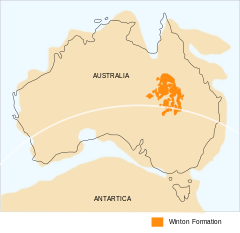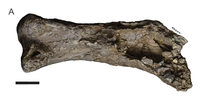Winton Formation
| Winton Formation | ||
|---|---|---|
Ma | ||
Approximate paleocoordinates 51°48′S 134°06′E / 51.8°S 134.1°E | | |
| Region | ||
| Country | ||
| Extent | Eromanga Basin | |
| Type section | ||
| Named for | Winton, Queensland | |
| Named by | Whitehouse | |
| Location | Bores in and around Winton | |
| Year defined | 1955 | |
 Formation distribution within Australia | ||
The Winton Formation is a
claystone. The sediments that make up these rocks represent the remnants of the river plains that filled the basin left by the Eromanga Sea - an inland sea that covered large parts of Queensland and central Australia at least four times during the Early Cretaceous
. Great meandering rivers, forest pools and swamps, creeks, lakes and coastal estuaries all left behind different types of sediment.
In some areas, the Winton Formation is over 400 metres thick. To bring with them such a huge amount of sediment, the rivers that flowed across these plains must have been comparable in size to the present-day Amazon or Mississippi rivers. As more and more sediment was brought in, the margins of the inland sea slowly contracted. By around 95 million years ago, the deposition was complete and the inland sea would never be seen again.
By virtue of its age and the environmental conditions under which the rocks it consists of were deposited, the Winton Formation represents one of the richest sources of dinosaur fossils anywhere in Australia.
Fauna
Lark Quarry
track siteA
Lark Quarry
in Australia, c.f. Tyrannosauropus and Skartopus, have been found in the Winton Formation.
Dipnoi
Dipnoi of the Winton Formation
| |||||
|---|---|---|---|---|---|
| Taxa | Species | Presence | Material | Notes | Images |
| Metaceratodus[3] | M. bonei | Isolated tooth plates | Lungfish belonging to the extinct family Ceratodontidae | ||
| M. ellioti | |||||
| M. wollastoni | |||||
Actinopterygii
| Actinopterygii of the Winton Formation | |||||
|---|---|---|---|---|---|
| Taxa | Species | Presence | Material | Notes | Images |
| Cladocyclus[4] | C. geddesi | Nearly complete skull and partial skeleton | |||
Squamates
Squamates of the Winton Formation
| |||||
|---|---|---|---|---|---|
| Taxa | Species | Presence | Material | Notes | Images |
| Varanoidea[5] | Indeterminate | A damaged posterior trunk vertebra | Originally considered as dolichosaurid (cf. Coniasaurus),[6] but reassigined | ||
Crocodyliformes
| Crocodyliformes of the Winton Formation | |||||
|---|---|---|---|---|---|
| Taxa | Species | Presence | Material | Notes | Images |
| Confractosuchus[7] | C. sauroktonos | Nearly complete skeleton preserving a juvenile ornithopod in its abdomen |  | ||
| Isisfordia | I. duncani | Nearly complete skeleton and partial skull, referred complete skull |  | ||
Dinosaurs
- Ornithischians
Ornithischians of the Winton Formation
| |||||
|---|---|---|---|---|---|
| Taxa | Species | Presence | Material | Notes | Images |
| Amblydactylus | A. gethingi | Lark Quarry. | Multiple footprints. | ||
| Ankylosauria[8] | Indeterminate | Three isolated teeth from left and right dentary and right maxilla | |||
| Neornithischia | Indeterminate | Tooth[9] | |||
| Ornithopoda[7] | Indeterminate | Digested remains associated with the holotype of Confractosuchus[7] | |||
| Ornithopoda | Undescribed | A nearly complete skull and mandible and at least three partial postcranial skeletons.[10] | Small-bodied, recovered as part of "a diverse clade of Gondwanan ornithopods that includes taxa from Australia, South America, and Antarctica" | ||
| Wintonopus | W. latomorum | Snake Creek and Lark Quarry track site. | Footprints. | An ornithopod. | |
- Sauropods
Sauropods of the Winton Formation
| |||||
|---|---|---|---|---|---|
| Taxa | Species | Presence | Material | Notes | Images |
| Australotitan[11] | A. cooperensis | A partial scapula, humeri, ulna, pubes, ischia, femora, presacral vertebral centrum fragments, and rib fragments. | A large diamantinasaurian sauropod that possesses a mosaic of features shared with titanosaurians with similar geographical and temporal range. Possibly a junior synonym of Diamantinasaurus.[12] |  | |
| Diamantinasaurus [13] | D. matildae[13] | A squamosal, quadrates, braincase, surangular, atlas intercentrum axis, cervical vertebrae, middle cervical neural arch, co-ossified sacral centra, cervical ribs, dorsal vertebrae, numerous dorsal ribs, fragmentary gastralia, coalesced sacral vertebrae, isolated sacral processes, scapula, coracoid, partial sternal plate, humeri, ulnae, radius, metacarpals I–V, manual phalanges, ilium, pubes, both ischia, femur, tibia, fibula, astragalus, and numerous fragments. | A diamantinasaurian sauropod known from partial cranial material. |  | |
| Savannasaurus[14] | S. elliottorum[14] | Posterior cervical vertebrae, cervical ribs, dorsal vertebrae, dorsal ribs, sacral vertebrae with processes, partial caudal vertebrae, fragmentary scapula, coracoid, sternal plates, incomplete humeri, shattered ulna, radius, metacarpals I–V, metacarpal IV, manual phalanges, fragments of ilia, pubes, ischia, astragalus, metatarsal III, and associated fragments. | A wide-bodied sauropod that was well adapted to the wet, temperate floodplain environment it inhabited. |  | |
| Sauropoda[7] | Indeterminate | Poorly preserved remains associated with the holotype of Confractosuchus[7] | |||
Titanosauriformes
|
Undescribed | Partial skull, consisting of a braincase, quadrates, quadratojugals, a left squamosal, postorbitals, and several unprepared elements. associated with a hind limb[15] | |||
| Wintonotitan[13] | W. wattsi[13] | A scapula, both humeri, both ulnae, both radii, near complete metacarpus preserving complete metacarpals II–V with proximal half of metacarpal I, fragmentary dorsal and sacral vertebrae and ribs, partial ilium, ischium, caudal vertebral series including anterior caudals, middle caudals, posterior caudals, proximal chevrons, and numerous unidentifiable fragments. | A titanosaur that is likely to be closely related to Australotitan, Diamantinasaurus and Savannasaurus. |   | |
- Theropods
Theropods of the Winton Formation
| |||||
|---|---|---|---|---|---|
| Taxa | Species | Presence | Material | Notes | Images |
| Australovenator[13] | A. wintonensis | Dentaries, dorsal ribs and rib fragments, gastralial ribs and fragments, partial ilium, ulnae, radius, manus metacarpals, unguals, femur, tibiae, fibula, astragalus, metatarsals, pedal phalanges, humeri, radiale, distal carpal, and manual phalanxes. | A theropod known from postcranial and cranial material.
|
 | |
Megaraptoridae[16]
|
Indeterminate | A partial skeleton, consisting of caudal vertebrae, metatarsals, a phalanx, and numerous unidentifiable fragments. | |||
Pterosaurs
| Pterosaurs of the Winton Formation | |||||
|---|---|---|---|---|---|
| Taxa | Species | Presence | Material | Notes | Images |
| Ferrodraco[17] | F. lentoni | A partial premaxillae, maxillae and dentaries, partial frontal, mandibular articular region comprising the surangular, angular and articular, partial cervical vertebrae, partial scapulocoracoid, partial ulna, partial radius, proximal and distal carpals, metacarpal IV, proximal end of metacarpal IV, fragmentary non-wing manual phalanges, partial first wing phalanx (IV-1), and associated fragments. | The most complete pterosaur from Australia and the youngest known anhanguerian. |  | |
Flora
| Flora of the Winton Formation[18] | |||||
|---|---|---|---|---|---|
| Taxa | Species | Presence | Material | Notes | Images |
| Marchantites | M. marguerita | Liverwort
|
|||
| Equisetites | Indeterminate | Axes | Horsetail | ||
| Aff. Lygodium? | Indeterminate | Fern pinna | |||
| Phyllopteroides | P. macclymontae | Numerous pinnule impressions | A fern belonging to the family Osmundaceae | ||
| Microphyllopteris | cf. M. gleichenoides | Frond fragment impression | A fern belonging to the family Gleicheniaceae | ||
| Tempskya | T. judithae | Permineralized false trunks | A tree fern |  | |
| Otozamites | cf. O. bengalensis | Leaves | Member of Bennettitales | ||
| Ptilophyllum | Indeterminate | ||||
| Pterostoma | Indeterminate | A possible cycad | |||
| Ginkgo | G. wintonensis, four other possible species | Leaf impressions (G. wintonensis) Dispersed cuticle | A gingophyte, genus extant. | ||
| Taeniopteris | Indeterminate | Leaf impression | A member of Pentoxylales, youngest record of the group in Australia | ||
| Emwadea | E. microcarpa | Seed cones | A member of Araucariaceae, more closely related to Agathis and Wollemia than Araucaria.[19] | ||
| Austrosequoia | A. wintonensis | Cones and leaved axes | A member of Cupressaceae | ||
| Araucariaceae | Indeterminate | Leaves | |||
| Cheirolepidiaceae | Four taxa | Dispersed cuticle | |||
| Lovellea | L. wintonensis | Permineralised flower | A member of Laurales | ||
Angiospermae
|
Indeterminate | Leaf impressions, cuticle fragments | At least ten distinct types, belonging to both dicotyledons
|
||
See also
- Lark Quarry Conservation Park
- Australian Age of Dinosaurs, which operates the Australian Age of Dinosaurs Museum of Natural History, and holds annual dinosaur digs in the Winton Formation
- List of dinosaur-bearing rock formations
- South Polar region of the Cretaceous
References
- ^ "Water resources - Availability - Queensland". Archived from the original on 3 June 2011. Retrieved 1 May 2011.
- ISSN 1342-937X.
- .
- .
- .
- ^ Scanlon, John D.; Hucknull, Scott (2008). "A dolichosaurid lizard from the latest Albian (mid-Cretaceous) Winton Formation, Queensland, Australia". Proceedings of the Second Mosasaur Meeting. 3. 3: 131–136.
- ^ S2CID 246756546.
- S2CID 129461328.
- ^ "Hypsilophodontid (Dinosauria:Ornithischia) from latest Albian, Winton Formation, central Queensland". Memoirs of the Queensland Museum. 52.
- ^ AN EXCEPTIONALLY PRESERVED SMALL-BODIED ORNITHOPOD DINOSAUR FROM THE LOWER CRETACEOUS (UPPER ALBIAN) WINTON FORMATION OF ISISFORD, CENTRAL-WESTERN QUEENSLAND, AUSTRALIA, AND THE DIVERSIFICATION OF GONDWANAN ORNITHOPODS[permanent dead link] SALISBURY, Steven W., University of Queensland, Brisbane, Australia; HERNE, Matthew C., University of New England, Armidale, Australia; LAMANNA, Matthew C., Carnegie Museum of Natural History, Pittsburgh, PA, United States of America; NAIR, Jay P., University of Queensland, Brisbane, Australia; SYME, Caitlin, University of Queensland, Brisbane, Australia; WITMER, Lawrence M., Ohio Univ, Athens, OH, United States of America SVP conference abstracts 2019
- PMID 34164230.
- PMC 11011616.
- ^ PMID 19584929.
- ^ PMID 27763598.
- ^ NEW SAUROPOD DINOSAUR DISCOVERIES IN THE LOWER UPPER CRETACEOUS WINTON FORMATION (CENOMANIAN– LOWER TURONIAN) OF QUEENSLAND, AUSTRALIA: IMPLICATIONS FOR TITANOSAURIAN EVOLUTION[permanent dead link] POROPAT, Stephen F., Swinburne University of Technology, Hawthorn, Australia; MANNION, Philip D., University College London, London, England; UPCHURCH, Paul, University College London, London, United Kingdom; ELLIOTT, David A., Australian Age of Dinosaurs Museum of Natural History, Winton, Australia SVP conference abstracts 2019
- PMID 32218963.
- PMID 31582757.
- S2CID 129098756.
- S2CID 129171237.
